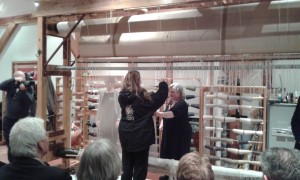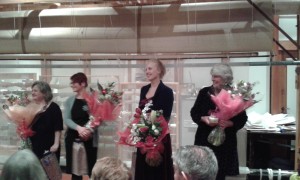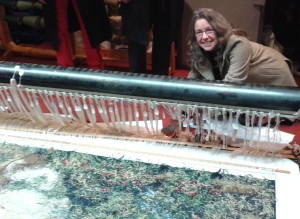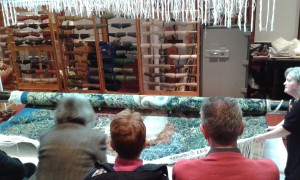
by Karen Thompson, University Teacher.
Frances Lennard, Margaret Smith and I were delighted to have been invited to join the cutting off ceremony at Stirling Castle for the last of the Unicorn tapestries, ‘The Mystic Hunt of the Unicorn’, just before Christmas. The tapestry was the final stage of a long-term partnership between the West Dean Tapestry Studio and Historic Scotland in a major project to present the interiors of James V’s Renaissance palace at Stirling Castle.
Over 60 invited guests including weavers, funders, representatives of Historic Scotland and West Dean, friends and family were present to participate in the ‘cutting off ceremony’ to celebrate the completion of the tapestry (below left). It represented the conclusion of the project which began with the planning phase back in 1997 with the weaving taking place between 2001 and 2014. Peter Buchanan, Project Manager for Historic Scotland, talked about the project from its inception 14 years ago to the completion of the tapestries. He also mentioned the major financial input from Helen Buchanan and the Quinque Foundation of America which came about because of Mrs Buchanan’s passion for historic preservation and conservation and a long-standing connection with Stirling. It was also interesting to hear how much funding was raised through donations from visitors to the castle who were fascinated to see the tapestries being woven. The design of the Stirling Castle Unicorn tapestries is a new interpretation of those held at the Cloisters Museum in New York. In total seven tapestries were woven involving 18 weavers from West Dean. Seven weavers worked on this last tapestry (below right) including two of the weavers who also worked on the first one in the set.
Images©University of Glasgow
The progress of the tapestry weaving has been incorporated into the teaching of the textile conservation students. Frances took students, who were then studying on the Winchester course, to see some of the first tapestries being woven at West Dean and this has continued with the Glasgow students being able to see the work at Stirling Castle. It has been fascinating watching the progress of the tapestries and interesting to hear how much the weavers have learnt about practices of the past through producing these tapestries as discussed in Caron Penney’s case study in Authenticity and Replication, The ‘Real Thing’ in Art and Conservation, the proceedings of a conference held by the Getty-funded Research Network for Textile Conservation, Dress and Textile History and Technical Art History.
The cutting off ceremony was full of tradition and poignancy. The last time such a large set of tapestries was completed in this country was in the nineteenth century with the Holy grail tapestries designed by Edward Burne-Jones and woven by Morris & Company in the 1890’s. As part of the tradition it is common practice that the weavers who wove the tapestry should not be the ones to cut it off, so people closely involved in the project were invited up to cut the tapestry off the loom. There was also the chance for other members of the audience to cut some of the warp threads. Not one to miss a historic opportunity, I was lucky enough to participate (below left). Once the tapestry was cut off the loom it was laid out for all to have a really close look at it (below right). The tapestry will now be blocked out and lined before it is installed in the Queen’s Inner hall in the summer of 2015. The evening was rounded off with wine, canapés and a roaring fire in the Great Hall; a perfect way to start Christmas.
Images©University of Glasgow





